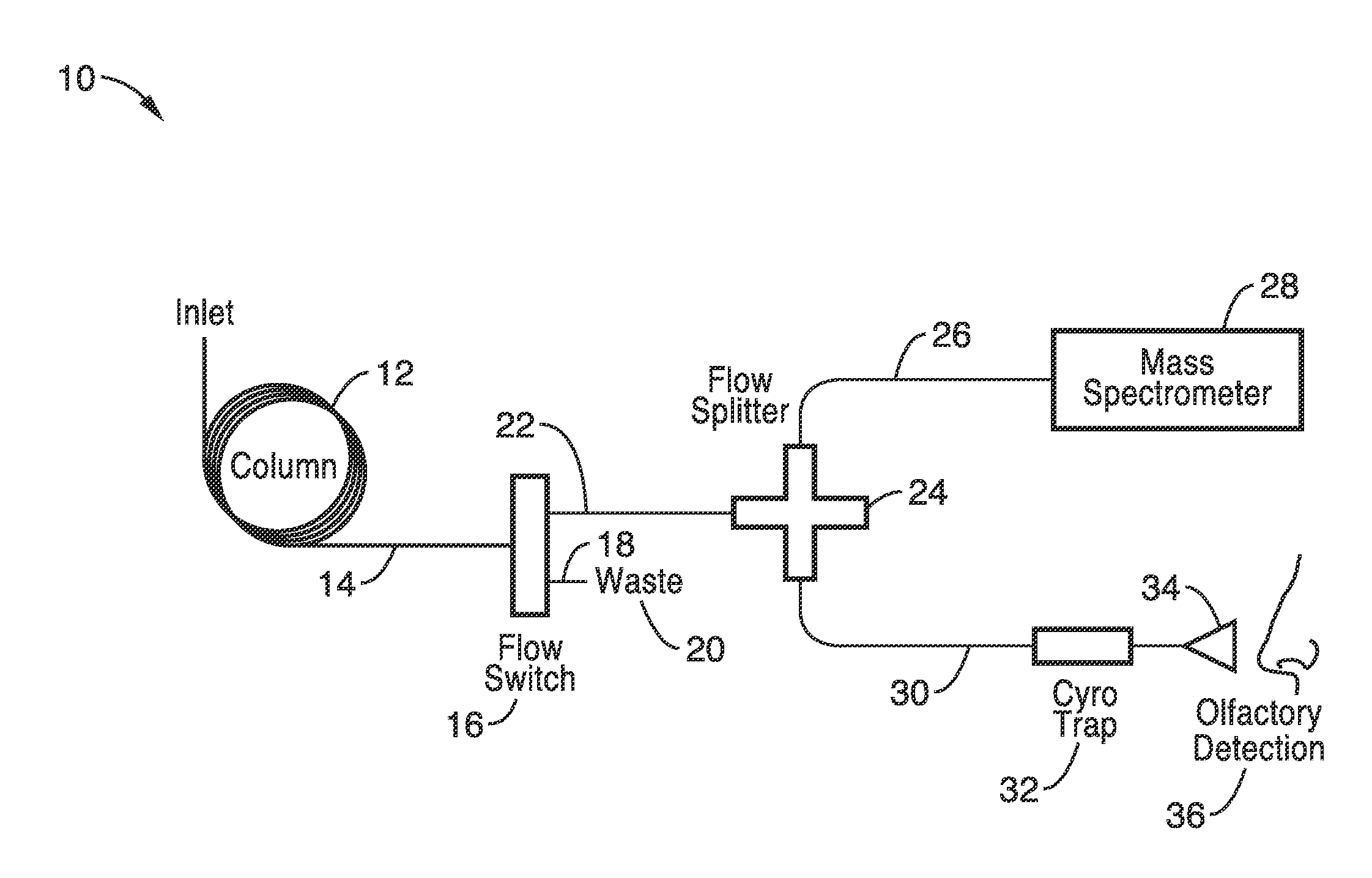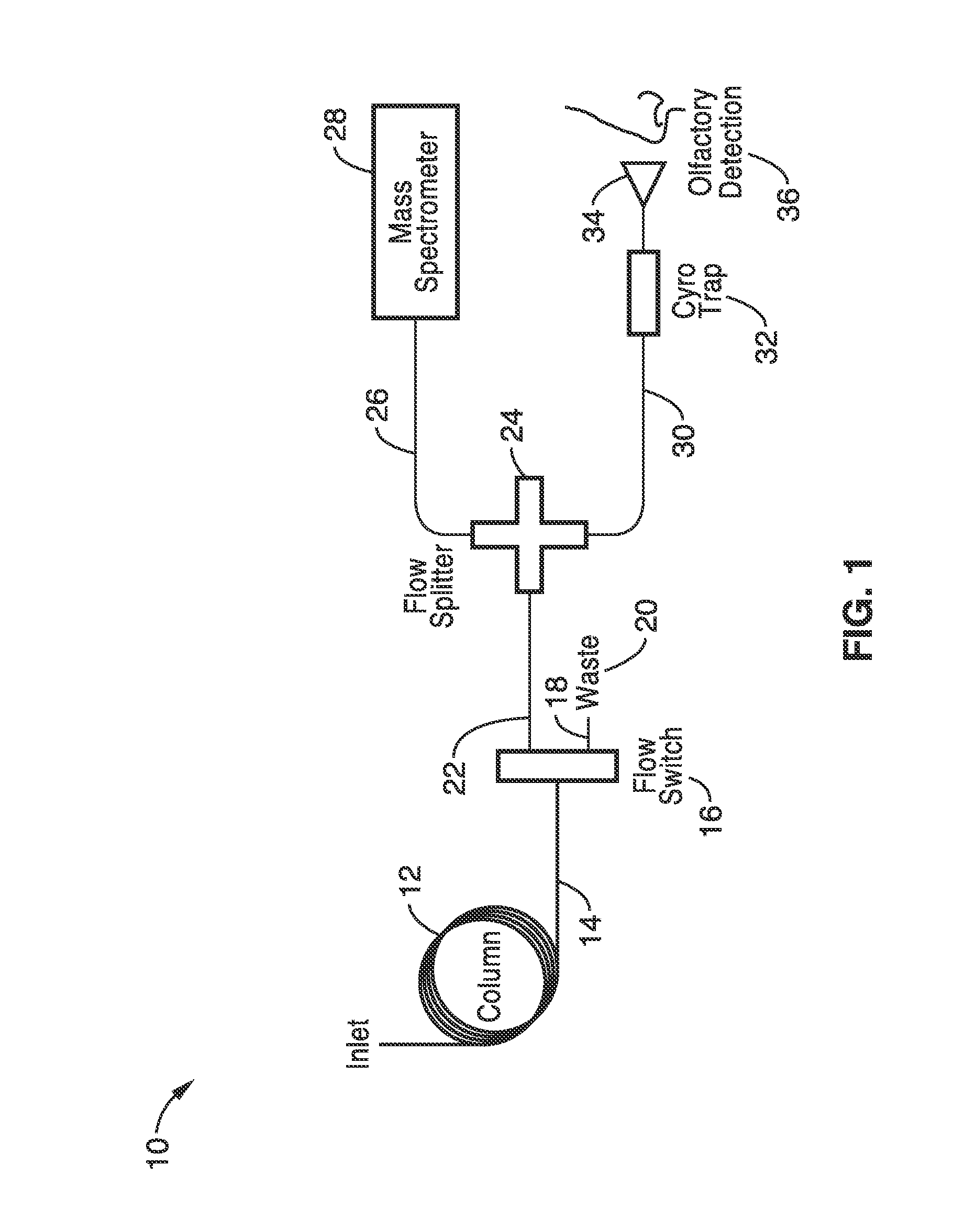Gas chromatography recomposition-olfactometry for characterization of aroma mixtures
a technology of aroma mixture and gas chromatography, which is applied in the field of aroma mixture characterization and analysis, can solve the problems of not well-developed understanding of how aroma mixtures work together in complex, everyday stimuli and activities
- Summary
- Abstract
- Description
- Claims
- Application Information
AI Technical Summary
Benefits of technology
Problems solved by technology
Method used
Image
Examples
example 1
[0066]In order to demonstrate the functionality of the apparatus and methods, an apparatus configured like the embodiment shown in FIG. 1 was constructed and tested. An Agilent model 6890 gas chromatograph / 5972 mass selective detector (GC-MSD) was modified with the addition of a Dean's switch apparatus (Agilent Technologies, Santa Clara, Calif.), auxiliary pressure controller (EPC, Agilent), splitter (Gerstel), cryotrap (Micro Cryo-trap and model 971 controller, Scientific Instrument Services, Ringoes N.J.) and olfactometry port (ODP-2, Gerstel, Linthicum, Md.). Deactivated fused silica was used for all transfer lines. The transfer line from the Deans switch to the splitter was 4 m in length. The dimensions of the transfer line from the splitter to the MSD were 1 m×0.15 mm; the dimensions of the transfer line from the splitter to the olfactory port were 1 m×0.25 mm resulting in a 1.86:1 split ratio between the olfactory port and MSD.
[0067]Chromatographic separation was performed usi...
example 2
[0070]By programming the switches to either cryotrap or exclude peaks or peak regions, two types of evaluations can be performed. In perceptual interaction experiments, all of the chromatogram except for a small section of peaks is cut away, and the section of interest is assessed as a mixture. In omission experiments, small groups of peaks (or individual peaks) are cut away and the rest of the compounds in the chromatogram are smelled as a mixture at the olfactory port by trained panelists.
[0071]To demonstrate the olfactometry aspects of the invention, lavender volatiles were introduced to the gas chromatograph capillary column for separation. Based on retention time, the Deans Switch sent specific packets of volatiles to the cryotrap according to one of 10 programs (W, O1-O3, P1-P6; Table 1, FIG. 3). At the conclusion of each separation run, the cold trap was heated and the mixture was sniffed and described by a sensory panelist. The W condition, analogous to a full aroma reconsti...
example 3
[0080]To further evaluate the separations, Correspondence Analysis was performed on the descriptors-by-mixtures data matrix to compare dimensionally-reduced latent trends in the sensory profiles of the mixtures to the differences evident in top descriptors for each mixture. Correspondence Analysis separates dissimilar categories in space; mixtures and sensory descriptors spaced closely together share more similarities than those spaced further apart. FIG. 4 is a graph of the volatile mixtures of lavender and FIG. 5 is a graph of lavender volatile mixture descriptors. The abbreviations for the mixtures in FIG. 4 correspond to those found in Table 1. Terms generated by the panelists to describe the perceived odor of from each Experimental Condition described in Table 1 were tabulated by frequency of use and used for the Correspondence Analysis.
[0081]As seen in the plot of FIG. 4, removing more volatiles generally results in greater dissimilarity between a given mixture and the all-vol...
PUM
| Property | Measurement | Unit |
|---|---|---|
| length | aaaaa | aaaaa |
| constant pressure | aaaaa | aaaaa |
| length | aaaaa | aaaaa |
Abstract
Description
Claims
Application Information
 Login to View More
Login to View More - R&D
- Intellectual Property
- Life Sciences
- Materials
- Tech Scout
- Unparalleled Data Quality
- Higher Quality Content
- 60% Fewer Hallucinations
Browse by: Latest US Patents, China's latest patents, Technical Efficacy Thesaurus, Application Domain, Technology Topic, Popular Technical Reports.
© 2025 PatSnap. All rights reserved.Legal|Privacy policy|Modern Slavery Act Transparency Statement|Sitemap|About US| Contact US: help@patsnap.com



